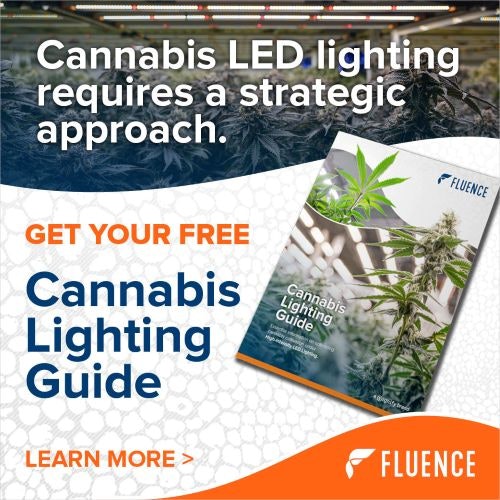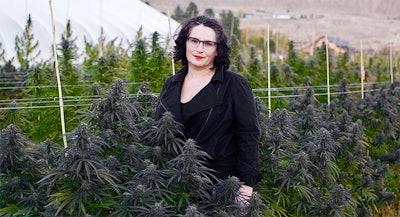
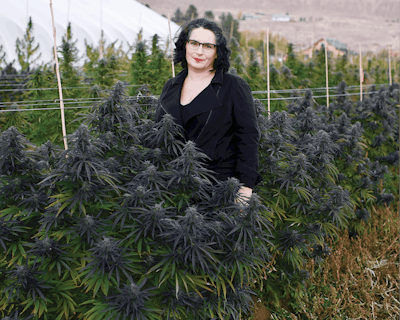
Jade Stefano, ND, co-owner of Puffin Farm in Ellensburg, Wash., is passionate about growing plants outdoors. As a farmer of regulated medical and adult-use cannabis since 2014, and hemp since 2019, Stefano has tunnel vision on growing as ecologically responsibly as possible. Strain on the power grid? No way, since as an outdoor grower, Puffin Farm uses significantly less electricity than indoor and greenhouse cultivation operations. Waste generation? No issue there—Puffin’s cannabis and hemp plant waste is made into compost and returned to the soil to increase fertility. And she uses only biocontrols and natural fertilizers.
All these practices have given Stefano and her small-but-mighty team peace of mind that they’re producing clean products. And with her CO2 extraction facility about 100 miles away in Seattle, Stefano is fortunate to have control throughout her supply chain. In the regulated cannabis market, she produces flower, vape cartridges, topicals, rosin and more. So, when the opportunity opened to operate in the hemp market after the passage of the Agriculture Improvement Act of 2018 (the 2018 Farm Bill), Stefano saw a way to offset her overhead and regulatory costs for her current product line. But this also created an opportunity to add more products that align with her standards, as well as widen her distribution channels.
In this Q&A interview with Hemp Grower Contributing Editor Cassie Neiden Tomaselli, Stefano shares more about her agricultural philosophy, the history of her farm, hemp opportunities that lie ahead, as well as her biggest lessons learned from growing hemp and cannabis in these rapidly evolving regulated markets.
Cassie Neiden Tomaselli: Will you share a little about the history of Puffin Farm?
Jade Stefano: Prior to i502’s legalization of adult-use cannabis, we were growing medical cannabis that was CBD [cannabidiol]-dominant in Seattle. [Editor’s note: Initiative 502 was voted into law in November 2012, legalizing a regulated adult-use cannabis marketplace in Washington.]
When i502 happened, we decided to transition to the regulated [i502] market. We founded Puffin Farm in 2014, and we’ve been in operation now for seven seasons growing adult-use cannabis.
We are both Sun+Earth Certified and Clean Green Certified, regenerative and organic equivalent third-party certifications, respectively. We are focused on climate-friendly cannabis and hemp that does not contribute to global warming. We are on a 20-acre riverfront farm in the Kittitas Valley. We have river-bottom soil that is a nice sandy loam consistency. That’s perfect for growing any crop you want.
Our i502 grow is 30,000 square [feet] of canopy inside a fence, and it’s got cameras and crazy security. [As for] the hemp farm, this was our second season that just finished. I would consider it a micro-hemp farm, basically 1 acre. We’re focusing on growing very high-quality, terpene-rich hemp using the same methods that we grow smokable and extraction cannabis [with]. And [it’s] dried the same way that we dry our [cannabis] crop.
The cannabis farm and the hemp farm are on the same parcel. We have our employees dual-employed, so they can go back and forth between the two.
Neiden Tomaselli: Before you operated in Washington’s hemp program, you were growing CBD-dominant varieties on the THC cannabis side of things. Can you share a little more of that experience and how it has helped your newer hemp operation?
Stefano: We have a reputation as having tasty CBD flower and extracts available [in the regulated cannabis market]. Even though CBD tends to be a smaller segment of the overall market, for us, it’s significant.
So, when hemp became legal, obviously one of the fears has been that it will put any kind of CBD products that are created in the regulated cannabis market in jeopardy [because hemp products will be] cheaper and more available. That definitely is something that we worried about.
[If we transitioned to the hemp market], we could have a source of CBD that we could produce cheaper without all the extensive regulations that we have with cannabis. In Washington, we are allowed to import hemp CBD into the regulated market and blend it with products that are then sold at adult-use cannabis stores.
We’re quality-control freaks and very wary of buying CBD from outside sources, especially highly processed isolates that are grown at massive scale and extracted with lots of chemicals. That’s one of the reasons we are growing it ourselves—so we can provide a CBD input into our two businesses [and] we have complete control of the supply chain.
Neiden Tomaselli: A lot of farmers are wary of purchasing genetics from an outside source, and others have been burned by bad actors. How do you select genetics at Puffin Farm?
Stefano: Genetics have been a total mess in the hemp market. I’ve seen and heard nightmare stories of people spending tens of thousands or hundreds of thousands of dollars on seeds that turn out to be hot for THC or hermaphroditic, suffering varying levels of crop failure.
It’s kind of the Wild West. The seed market has been unregulated. There are all kinds of yahoos jumping into it and making seeds. They’re not scientists or breeders, and they really have not had the years and years it takes to stabilize the genetics that will consistently put out under 0.3% THC [and] non-hermaphroditic plants. It is not an easy task. Unscrupulous “breeders” buy seeds of dubious origin, breed them, and then try to sell the seed with very little testing and false claims.
We have been super careful. We had some existing genetics that test under 0.3%. We decided to grow our known cultivar from clone exclusively and have avoided the seed fiasco. We did some test crops with seeds the previous season, and they were all over the place, including hermaphrodites and other issues. We got really uncomfortable with what we were seeing and decided to just completely stay away from seeds for the time being.
Our cannabis farm is sited several hundred yards from our hemp farm, so if we ended up with a hermaphroditic crop, it could cause massive damage [via pollination] to our main cannabis crop—which really is our bread and butter. The hemp chemovar we grow is an amazing variety [with] a great terp profile. It has a very nice fruity flavor, kind of like Juicy Fruit gum.
Neiden Tomaselli: How do you start those genetics for each growing season?
Stefano: Once the plants are cloned and rooted, they go into 4-inch pots, and they are kept in a greenhouse to mature for one to two months until they are well-established, [strong] enough to survive the wind, but not too big—[then they’re planted] in June. If they get too large, they actually do worse outdoors—but if they’re too small, they get stunted. We try to find that sweet spot, usually about 12 to 18 inches high at most, and then they [are planted] right into the ground.
Neiden Tomaselli: Let’s talk about the climate in Washington where you’re located and how that impacts your crop health.
Stefano: We are in the foothills on the eastern slope of the Cascade Mountains. Our elevation is about 1,200 to 1,300 feet. We’re just where the foothills turn into the valley. We’re along the [Yakima] River. It’s sort of a high-desert environment—hot, dry summers, cold winters. We do have quite a bit of wind, which is not the easiest thing, but the plants actually do well with it. It helps keep everything nice and aerated, [which prevents] mold and mildew from taking hold. It makes the plants very strong. Their stems really beef up without much support.
Neiden Tomaselli: Could you share a little more about your nutrient regimen and other ways you keep your plants healthy?
Stefano: We use a lot of cover crops such as nitrogen-fixing legumes. In our hemp field last season, we did not fertilize at all. The previous season, we put a very thick cover crop of purple vetch down, which is nitrogen-fixing, and it really flourished. It did what it was supposed to do, [absorbing] nitrogen from the atmosphere, [dying] back, and that was then incorporated into the soil for the current season. The plants were so healthy, they needed absolutely nothing.
Every year we do a soil test in the spring and see where we’re at and if we need to add anything. If there are any nutrient deficiencies that have popped up or if the organic matter is low, we’ll see that and adjust accordingly. We only amend the soil as needed. Some years we might get a little deficient in sulfur or calcium, for example, and we’ll have to add specific amounts of [those] based on the soil tests.
Our hemp field is actually on one of the more fertile parts of our farm. It’s got a pretty thick layer of old river-bottom soil that doesn’t need a lot of additives.
Neiden Tomaselli: What about pest issues? Have you seen any where you’re located? If so, how do you combat them?
Stefano: We have experienced cannabis aphids recently. They popped up several years ago. They’re very aggressive, so they are something we’re very proactive about. The treatment we use for them is beneficial insects, specifically green lacewings and parasitic wasps. Early and frequent release of these beneficials is crucial to success.
While the plants are in the nursery and early in cultivation, [we go] very heavy on various beneficial insects to kind of nip it in the bud. Prevention is much easier than a cure. It’s not a matter of if you will experience pests, it’s a matter of when.
As hemp and cannabis cultivation spread and the industry grows, cannabis-specific pests such as cannabis aphids and the hemp russet mite are going to spread [and become] prevalent. These pests were unheard of three to four years ago, but they have spread rapidly with the legalization of Cannabis sativa species and are now considered endemic at both hemp and adult-use cannabis farms where they arrive via poor biosecurity, or more alarmingly, on the wind.
We spend a good deal of money on [beneficial insects], as we don’t use pesticides on our outdoor growing crops. There are some [biopesticides] you can use, but you might need special equipment to be able to spray a field, so insects are a great way to go.
Neiden Tomaselli: And disease? Botrytis, powdery mildew—what has been your experience with these and how have you combatted them?
Stefano: Fungal disease results from a combination of genetic susceptibility to the fungal pathogen and environment. Botrytis is very cultivar- dependent. And really the only way we’ve found [to avoid it] is to grow cultivars that are genetically resistant to it. You don’t want to spray a lot of moisture on your plants at the wrong time of day—that will make it worse. But at the end of the day, there are some cultivars that no matter what you do, no matter how dry the weather is, once those buds reach a certain size, they get [infected]. You just have to cull those cultivars from your operation. You can’t grow them.
Powdery mildew (PM) is a little bit different. It’s mostly a problem on the leaves but can infect buds if unchecked. It’s also cultivar-[dependent], but it’s entirely manageable in a way Botrytis is not. Once you get powdery mildew into your genetics and environment, it’s very hard to get rid of. The best practice is to never acquire it to begin with, but that’s not always realistic. One of the downsides of cloning is that powdery mildew will stay on your clone line forever, you’ll never totally get rid of it, but it’s totally manageable with organic products.
That’s one of the benefits of growing with seed, is that you can start with 100% clean genetics every year. We typically only see issues with powdery mildew in the greenhouse, as it’s a more humid environment with less air circulation than outdoors. Even with fans and good circulation in a greenhouse, controls and prevention for PM are still needed.
For preventative spraying, we use potassium bicarbonate, which is similar to baking soda and OMRI-listed. When they’re baby plants in the nursery, we need to spray every three days as a preventative. Once they go outside, we have very few issues with powdery mildew on our hemp because of our dry climate. Our cultivar is not very susceptible, so spraying is not necessary.
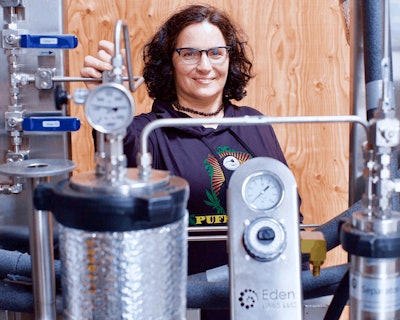
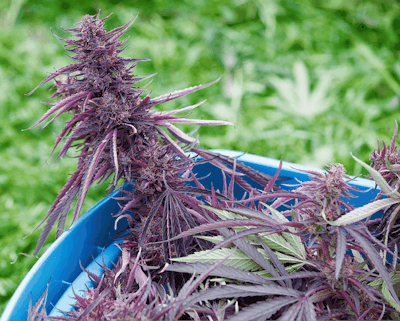
Neiden Tomaselli: Can you speak to the differences in working with different regulatory bodies for both of your crops?
Stefano: It’s the Washington State Liquor and Cannabis Board [WSLCB] that regulates cannabis. They were a deputized police force. The agents would have badges, bulletproof vests and guns. When we first started, they would show up like that, and it actually created quite a bit of PTSD for many people in the cannabis space who had experienced years of being afraid of the police. It was not a good feeling.
They’ve actually revamped the agency in the last couple months. It’s no longer going to be a police force, and they’re turning it into an education division. It took many years, lots and lots of complaints from people feeling like they were being treated as criminals. There was a lot of fear and anxiety for the first five, six years where people felt like they were being hassled and fined for tiny things. I’ve lost sleep over it because the rules are so intense.
You compare that to the hemp space, where almost anybody with $1,200 can send a single piece of paperwork [to the Washington State Department of Agriculture] and get a license. They do a background check, but a basic one, and then you’ve got the license.
And they come once a year to do the THC testing [about two] weeks before harvest, and then that’s it. If you pass, you get a certificate, and then you’ve got something you can sell. If it’s not good, I guess in certain cases, you’d have to destroy the crop. That’s the worst of it.
I do feel for people who got swindled or got bad seeds and ended up in that position, but doing the due diligence as a potential hemp grower on the genetics can’t be overemphasized. It’s so important. It’s not worth taking any risks because [regulators] will destroy the crop. You’ll lose tons of money and time and energy. Having dealt with the [WSLCB], we were well-prepared for mitigating those risks and understanding the green rush climate involved in all of it.
Neiden Tomaselli: What new hemp products are you developing and where do you intend to sell them?
Stefano: The first product we’re launching will hit the market soon. It’s an all-purpose topical hemp oil, extracted using a traditional herbal medicine method, where the hemp flower is extracted in a carrier oil. It can be used as a massage oil, hair oil, a muscle rub and a skin conditioner. It’s made from organic ingredients that are completely safe so you can use it for anything. I’m a naturopathic physician, so I look at product development from a natural medicine and herbal products point of view, using organic and high-quality ingredients.
We’re also working on other topicals, which will have other herbs in them besides cannabis, so there’ll be a synergistic effect between those herbs and the cannabis. The hemp we use is whole-plant, with all the flowers [and original terpene profile]. We’re looking at launching several products in the next month or two.
We’re going to start with our cannabis retailers. They’re allowed to carry CHABA products—that’s Cannabis Health and Beauty Aids, a Washington state designation. The CHABA law was passed in 2015 [allowing] hemp topicals [to] be sold anywhere. They can be sold at grocery stores, pharmacies, and licensed cannabis retailers can sell these hemp products next to their regulated cannabis products.
So, we’re going start marketing them to our retail network of cannabis stores, and then we’re going to move from there to a wider market—supermarkets, herb stores, possibly online as well. But we want to test them out in our existing network initially. And the great thing is, whereas the cannabis products all get a sales tax of 37%, these hemp products will only be taxed the regular sales tax, which is 10% [depending on the municipality].
Neiden Tomaselli: What are your future plans? Do you plan to expand your operations any time soon?
Stefano: We could absolutely put another 8 acres at this location if we wanted to; however, we are going to wait to see what the local market looks like. Right now, the price for hemp is very low, so unless we are going to use it for our own product line or have somebody that specifically wants what we’re growing, we’re not too eager to expand.
And it would involve more infrastructure and drying space, which is always a big problem for hemp. And that’s one of the things we’ve seen in the last couple years is hemp farms, they’ve got 100 acres of hemp [with] nowhere to dry it.

